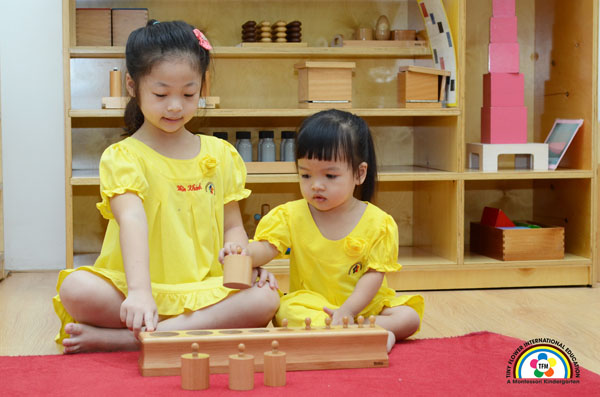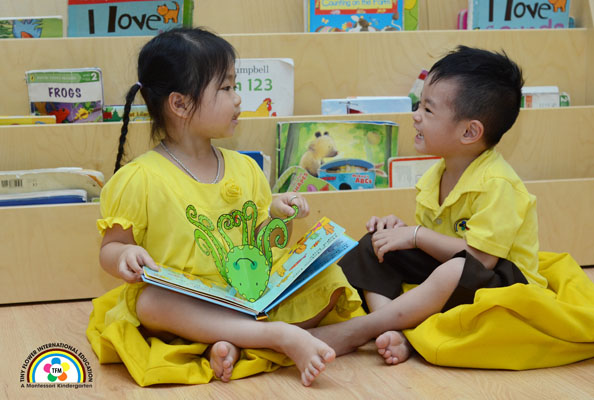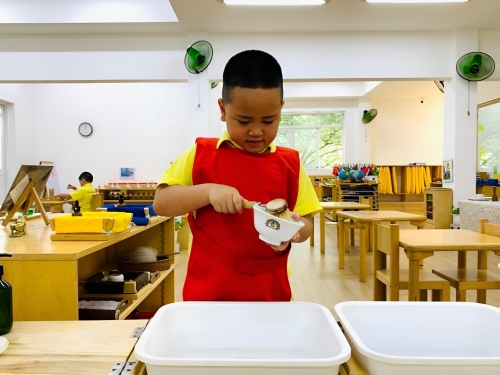The importance of the three-year age grouping is such that for a school to be recognized by some international Montessori organizations classrooms have to fulfill this requirement to be considered truly Montessori and thus eligible for accreditation.
The fact is that through the preservation of the originally required 3 year-year mixed age group, children benefit the most. For older children to become guides to the younger ones, and learning and teaching to be constantly present at this level, often requiring little intervention from adults, a two year span is really not enough. This is not a mere convention, it is based on scientific observation, and it allows for older children to validate their knowledge and skills and share in ways that otherwise would not happen. Five and six year olds naturally become caretakers of the classroom, care for and become role models for the 3 and 4 year olds. Socially, this allows for a level of engagement that developmentally is not favored when 3 and 4 year olds, and 5 and 6 year olds are split in two groups. The fact is that one single year of difference does not let children feel younger or older in relation to their peers. Their skills are far too identical. The propensity is then for contention and competition rather than for cooperation.

When children have access to an environment built around the three-year age grouping, Maria Montessori said, nature and nurture work hand-in-hand. “The main thing”, said Montessori “is that the groups should contain different ages, because it has great influence on the cultural development of the child. This is obtained by the relations of the children among themselves. You cannot imagine how well a young child learns from an older child; how patient the older child is with the difficulties of the younger.”
Social development is one of the main benefits of this mixed age grouping. We often hope that children behave “nicely” towards each other, become “sociable”, and learn how to “share” and so on. Adults often try far too hard to teach “good habits,” “good manners” and “kindness” to children when all these naturally and spontaneously develop in a Montessori prepared environment.
Developmentally, children are not able to share until they can identify with their peers. But learning how to be social is done naturally and spontaneously when children live together and share the same communal space with other children and adults. Children become sensitive to the needs of others as they get older and have role models that express concern, engage in mutual help, show empathy and impart their newly acquired skills. Younger children also seem to be far more at ease with older children, as Dr. Montessori noted, than with adults. A five year old can often teach a new skill to a 3 year old with an economy of movement and dexterity unmatched by almost any adult.

Some children, especially the very young ones, also often learn from observing others silently and intently. “In doing this they absorb much more than it seems, and are already preparing themselves for more active social participation in the community,” observed Dr. Montessori.
In this environment, children develop self-confidence, self-motivation and consistently build on previously learned skills. Since children are natural scientists and love to experiment in myriad ways, any newly learned skills are exhaustively applied to all areas.
Cooperation rather than competition becomes a natural response to all sorts of different situations and challenges. Children will help each other when cleaning up after work, putting things away and caring for the environment in general, as well as each other, and that includes peaceful conflict resolution.
Children also learn a lot through imitation as well as experimentation. They don’t only look up to their peers, they also look forward to becoming like them one day, and being able to help others and show others what they are able to do and have learned. This becomes a natural process and part of their being. And it is all based upon the advantages of the traditional Montessori three-year age grouping. As young children grow up caring for each other and nurturing their self-esteem and self-confidence and respect and empathy for others, they develop into adults that care in a balanced way for both the end result and the process. They are able to recognize that the end does not always justify the means, which is a much needed attitude in terms of sustainability when it comes to partnerships, environmental protection, business and profit making, etc.
The case for this three-year age grouping in Montessori is not difficult to make. Indeed, it is essential and easy to recognize that there is a reason for Montessori schools to offer it without compromise. If parents want the best for their children, this should be one sign they should look for, and indeed request.
 VN
VN








